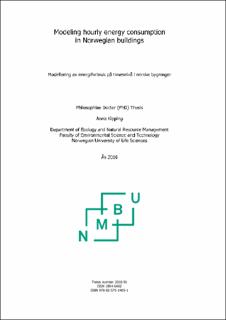| dc.description.abstract | Growing world population, unabated use of fossil fuels, and economies aiming at continuous growth exhaust the planet’s natural resources and add to an augmented greenhouse effect. Besides limiting population growth in less developed regions, reducing per capita energy consumption in more developed regions, substituting fossil and nuclear fuels by renewable energy carriers is considered a major step towards a sustainable development. The integration of renewable energy sources into the energy system can reduce pollutants and greenhouse gas emissions connected to energy conversion processes and ensure energy supply also in a long-term perspective. However, the varying supply of renewable energy supply implies challenges to existing energy systems, where traditionally supply used to follow demand. In order to plan, design, and manage modern energy systems sound estimates on regional energy demand with high temporal and spacial resolutions are needed. Due to the area-wide installation of smart energy meters time series of individual hourly or sub-hourly energy consumption data become available. In combination with cross-sectional information, such as household characteristics or building physics, valuable data sets can be formed, allowing the development of detailed consumption models.
In this thesis the key factors for energy consumption in Norwegian buildings are analyzed, and a simple approach for modeling hourly energy consumption in different consumer groups within household and service sector is presented. The models are based on panel data sets consisting of hourly meter data combined with cross-sectional data, weather data, and calendric information. The individual impacts of different heating systems on hourly electricity consumption in households are assessed, yielding for example insights about average reductions in hourly consumption in case air-toair heat pumps or wood stoves are used. Moreover, the impacts of further householdor dwelling-specific variables, such as number of residents or dwelling type, are discussed, and a simple method for disaggregating modeled hourly electricity consumption into a temperature-independent and a temperature-dependent component is applied. Comparing goodness of fit of two regression models based on hourly and daily mean values of local outdoor temperature yields that daily mean values are sufficient for modeling hourly electricity consumption, which facilitates the input data requirements. The modeling approach is further applied to both hourly electricity and hourly district heat consumption in office buildings and schools. A comparison of modeled total energy consumption in buildings with electric and district heating, correspondingly, indicates that in office buildings with district heating heat consumption in the morning starts earlier than in buildings with electric heating, and that schools with district heating on average apply less indoor temperature reduction during night-time, weekends, and school holidays than schools with electric space heating. Finally the method is used to model historic aggregate electricity consumption in households and service
sector in each Norwegian county, and to generate rough forecasts on hourly electricity consumption in Oslo in 2040. Temperature forecasts for 2040 imply increased temperatures during the entire year, and three different scenarios on population development assume low, medium, and high population growth. The forecasts indicate increased electricity consumption from 2013 to 2040 for all three population scenarios, which is mainly due to an increase in modeled consumption for electric appliances and tap water heating. Modeled electricity consumption for space heating purposes decreases in the low population scenario, slightly increases in the medium scenario, and only exhibits a considerable increase under the assumption of high population growth. The overall results of this study indicate that modeling aggregate energy consumption in households and service sector based on a bottom-up regression model approach is
useful, but that the availability of building stock related input data is a prerequisite for achieving meaningful results, both for modeling historic consumption and forecasting. Moreover, important factors like thermal building standard or building age were not considered in most of the models, so that the effects of a building stock renewal could not be assessed. Larger samples of meter data and cross-sectional information, covering all Norwegian regions and sectors would enable developing further, more reliable
models which could be used to perform forecasts on hourly energy consumption in all counties. | en_US |

